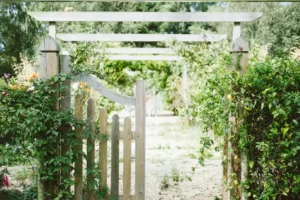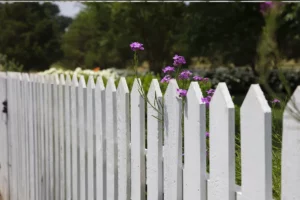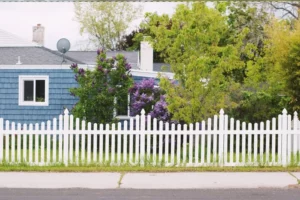When you have a shed and a fence in your backyard, you might find yourself with a space between them that seems too small to be useful yet too big to ignore. Don’t let this awkward gap go to waste! There are plenty of creative and practical ways to utilize the space between your shed and fence to enhance the functionality and aesthetics of your outdoor area. In this article, we’ll explore various ideas to make the most of this often overlooked space.
Vertical Gardens
Transform the space between your shed and fence into a vibrant vertical garden. Install wall-mounted planters or hanging pots to cultivate a variety of plants, flowers, and even herbs. This not only adds a splash of color to the area but also helps purify the air and attracts beneficial pollinators.

Mini Orchard
If you have enough sunlight, consider planting dwarf fruit trees or berry bushes along the gap. This mini orchard can provide you with fresh, homegrown fruits while making use of the space in a productive way.
Outdoor Storage
Why not use the gap for its original purpose – storage? Install shelves, hooks, or pegboards on the shed or fence to create a space for gardening tools, outdoor equipment, or even a small composting station.
Decorative Screens
Enhance the visual appeal of the space by adding decorative screens or trellises between the shed and fence. These screens can serve as a backdrop for climbing plants, creating a charming and private nook.
Cozy Seating Area
Create a cozy outdoor seating area by placing a bench, a few cushions, and a side table in the gap. This becomes a perfect spot to relax with a book or enjoy a cup of coffee amidst a green setting.
Wildlife Habitat
Encourage local wildlife by adding features like a birdbath, bird feeder, or butterfly garden. Turn the space into a haven for these creatures, making your backyard a more inviting and dynamic ecosystem.
Vertical Storage
Maximize storage by installing vertical shelving units against the shed or fence. This is an excellent way to store gardening supplies, pots, and other outdoor essentials without taking up valuable ground space.
Mosaic Walkway
Lay down a mosaic pathway that winds through the space. Use colorful tiles to create intricate patterns that add an artistic touch to the area and guide you through the garden.
Creative Lighting
Install outdoor lights along the fence and shed to illuminate the space at night. Whether it’s string lights, lanterns, or solar-powered path lights, they’ll add ambiance and make the area functional even after dark.
Outdoor Art Gallery
Hang weather-resistant artwork or sculptures on the shed or fence to create an outdoor art gallery. This transforms the gap into an interactive and visually stimulating space.
Pet Play Zone
For pet owners, the gap can be transformed into a designated play area for furry friends. Lay down pet-friendly turf, add toys, and create a secure space for your pets to enjoy the outdoors.
Water Features
Consider installing a small water feature, like a fountain or a small pond, to add a soothing element to the space. The sound of running water can create a calming environment.
Vertical Herb Garden
Utilize the space for a vertical herb garden. Plant different herbs in stacked planters or pockets, providing you with fresh herbs for cooking right outside your shed.

Mini Greenhouse
If you’re an avid gardener, use the space to set up a mini greenhouse against the shed. This allows you to start seedlings early and extend the growing season.
Reflective Mirror
Place a large mirror on the shed wall facing the fence. This creates an illusion of extra space and reflects the beauty of your garden.
How close to a boundary fence can I build a shed?
The distance you can build a shed from a boundary fence can vary depending on the local zoning regulations, building codes, and property laws in your specific area. These rules are often set by your local municipality or jurisdiction. Generally, they are put in place to ensure safety, proper land use, and to prevent disputes between neighbors.
To determine how close you can build a shed to a boundary fence, you will need to consult your local building department or zoning office. They can provide you with the specific setback requirements for your property. A setback is the minimum distance that a structure must be located from property lines, fences, and other structures.
Common setback distances might range from a few feet to several feet, or even more in some cases. The setback requirements could also differ based on the size of the shed, the type of property (residential, commercial, etc.), and other factors. It’s important to check with the relevant authorities to ensure you’re in compliance with the regulations.

Failing to follow these regulations could result in fines, legal disputes, or the need to move or modify your shed. Always consult your local authorities before proceeding with any construction project to ensure you are following the appropriate guidelines.
How do you soften the look of a shed?
Softening the look of a shed involves incorporating design elements and landscaping techniques to make the structure blend more harmoniously with its surroundings. Here are a few suggestions to assist you in attaining that goal:
Paint or Stain
Choose a color that complements the natural environment, such as earthy tones or muted colors. This will help the shed blend in better with the landscape.
Vegetative Cover
Consider growing climbing plants or vines on trellises around the shed. This will not only add greenery but also help the shed visually blend with the surrounding vegetation.
Landscaping
Plant shrubs, bushes, and flowers around the shed to create a garden-like setting. Use a mix of native plants for a more natural look.
Pathway
Lay down a pathway leading to the shed. This can be made of gravel, stepping stones, or even a wooden walkway. A pathway helps draw the eye away from the shed itself.
Window Boxes
Install window boxes with colorful flowers or trailing plants. This adds a touch of charm and softness to the shed’s exterior.
Decorative Accents
Hang outdoor artwork, decorative panels, or other design elements on the shed’s walls. This distracts from the shed’s utilitarian appearance.
Natural Materials
Incorporate natural materials like stone, wood, or even bamboo in the shed’s design. These materials will harmonize with the environment.
Roof Greenery
If feasible, consider adding a green roof with low-maintenance plants. This not only softens the look but also provides environmental benefits.
Furniture and Seating
Place outdoor furniture near the shed to create a cozy space. This takes the focus off the shed itself and encourages people to view the area as a whole.
Soft Lighting
Install soft outdoor lighting around the shed. Warm and subtle lighting can make the area more inviting and reduce the visual impact of the shed.
Natural Screens
Create natural screens using tall grasses, bamboo, or other plants to partially obscure the view of the shed.
Weathered Look
If the shed is made of wood, allow it to weather naturally over time. This can give it a more rustic and charming appearance.
Reflective Surfaces
Incorporate reflective surfaces like decorative mirrors or water features nearby. These can create the illusion of more space and distract from the shed’s appearance.
Permeable Paving
If you’re considering a pathway, opt for permeable paving materials like gravel. This allows for better water drainage and a softer visual effect.
By using a combination of these techniques, you can soften the look of the shed and make it a more appealing part of your outdoor space.
How can I make the most of my small shed’s space?
Maximizing space in a small shed requires careful planning and organization. Maximize the use of the available space with these helpful tips:
Declutter
Before you start organizing, go through all the items in your shed and decide what you really need to keep. Remove or contribute items that are no longer useful or necessary. This will create more space right away.
Vertical Storage
Utilize the vertical space in your shed by installing shelves, hooks, and pegboards on the walls. This will free up floor space and keep your items easily accessible.
Categorize Items
Group similar items together. This will help you see what needs to be stored and what kind of storage solutions are required.
Shelving
Install sturdy shelves that go all the way up to the ceiling. Store items you don’t use frequently on the higher shelves and keep the items you need more often within easy reach.
Pegboards and hooks
Use pegboards or hooks to hang tools, gardening supplies, and other objects. They are kept off the ground and are now easily reachable.
Overhead Storage
If the shed has a high ceiling, consider installing overhead storage racks or hooks for items that are used less frequently.
Use Bins and Containers
Group small items together in clear plastic bins or containers. Assign names to the containers for effortless recognition of their contents.
Folding and Stackable Furniture
If you use the shed as a workspace, consider using folding tables and stackable chairs. These can be easily put away when not in use, freeing up more space.
Door and Back of the Door Storage
Utilize the back of the shed door or the inside of the door with hanging organizers or racks. This is a great place to store smaller items like tools and gardening gloves.
Create Zones
Divide your shed into zones based on the types of items you’re storing. For example, have a gardening zone, a tool zone, a sports equipment zone, etc. You’ll find things more quickly if you do this.
Pegboard Tool Wall
Install a pegboard wall for your tools. Outline each tool on the pegboard to easily see if anything is missing. This keeps your tools organized and easy to find.
Utilize Corners
Install corner shelves or corner storage units to make use of otherwise unused space.
Repurpose and Multi-Use Furniture
Consider using furniture that can serve multiple purposes, like benches with storage underneath.
Regular Maintenance
Regularly go through your shed to reorganize and declutter. This will help you maintain an organized space over time.
Optimize Layout
Arrange items in your shed based on frequency of use. For ease of access, keep commonly used objects close to the door.
That the key to maximizing space is efficient organization and regular maintenance. Take some time to plan out your shed’s layout and storage solutions, and don’t be afraid to get creative with your solutions to make the most of your small space.
FAQs
Can I combine multiple ideas to make the space more versatile?
Absolutely! Feel free to mix and match ideas to suit your preferences and needs. For example, you could have a vertical garden with a seating area beneath it.
Are these ideas budget-friendly?
Many of these ideas can be adapted to fit different budgets. You can start small and gradually expand as you see fit.
What if I’m not a skilled gardener?
No worries! Some ideas, like decorative screens or outdoor art, don’t require gardening skills. Choose options that align with your interests and expertise.
How do I maintain the plants in a vertical garden?
Regular watering and occasional pruning are key. You can also opt for low-maintenance plants if you’re concerned about upkeep.
Can I hire a professional to implement these ideas?
Absolutely. If you’re not confident in your DIY skills, hiring a professional landscaper or designer can help bring your vision to life.
Final Thoughts
The space between your shed and fence offers untapped potential for creativity and functionality. By implementing these ideas, you can turn this seemingly insignificant area into a captivating and practical part of your outdoor haven. Whether you choose to cultivate greenery, create a cozy corner, or embark on a DIY project, the possibilities are as endless as your imagination.